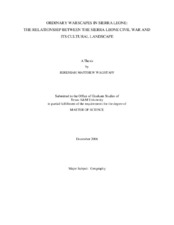| dc.description.abstract | The recent civil war in Sierra Leone (1991-2002) saw massive migrations
amongst the civilian population and widespread damage to villages and towns. This
study combines elements of military and cultural geography to ask the questions of how
the events of the war changed the cultural landscape and how the cultural landscape
influenced the course of the war. Fieldwork for this study was conducted during the
summer of 2005 in the Eastern Province and included numerous semi-structured
interviews regarding the landscape histories of villages, towns, and various temporary
camps.
These findings revealed that a clear relationship existed between the civil war
and the cultural landscape. On the one hand, the war caused dramatic changes in the
morphology of the cultural landscape, creating three distinct landscapes (pre-war, wartime,
and post-war), while on the other hand the cultural landscape went far to structure
the character of the war.
In order to understand how the cultural landscape structured the war one must
first consider how the landscape was perceived by each major faction (Revolutionary
United Front, Sierra Leone Army, and Civil Defense Forces) as presenting a unique set
of risks and opportunities. This perception was based in their strategic intentions and
capabilities. Intentions can be understood as military objectives (derived from political
goals), while capabilities can be understood as factors which constrain and enable action.
Since each faction had different military objectives and capabilities they each perceived the landscape in a unique manner and this perception influenced their military
operations.
It is recommended that cultural geographers begin to study the impacts of war on
the landscape and that military geographers expand their focus on the physical landscape
by taking into account the role of the cultural landscape and environmental perception. | en |


